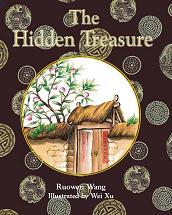| ________________
CM . . .
. Volume XIII Number 21 . . . . June 8, 2007
excerpt:
Kevin and Robin’s grandfather loves to tell folktales from “a far-away, ancient country called China.” Over a plate of steamed bread-roll “mantou,” Grandpa launches into a story about an elderly man who was neglected by his three sons. Living alone in a run-down mud hut, the man wished he had “gold to gain respect from his sons and jewels to please his daughters-in law.” A visiting neighbour found the man frail and delirious and ran to tell the three sons about the old man’s murmurs of a treasure trove. The greedy children all fought to have their father stay with them in order to be the first to learn where their suspected inheritance was buried. At first, the old man was revived by all this outpouring of attention and care, but, when he realized their duplicity, he lost his will to live. His dying words were: “Near the northwest corner of the south wall....” The couples raced to the area and began digging, but, before long, one of the wives gave out a shriek, and the mud wall began to fall. At this point, the story-within-the-story abruptly ends. Kevin and Robin want to know what happened next. Did the wife yell because she found the hidden treasure or because the wall was crumbling? What happened after the wall came down? Grandpa gives a wishy-washy answer, saying old Chinese stories teach a moral lesson, but, in modern Canadian culture, the ending would be kinder. He then tells his grandchildren to write their own conclusions. In the last four pages, the children help Grandpa plant a peach tree which is a symbol of “the love we have for each other and the values we carry in our tradition.” This multicultural story has some weak spots. The “choose-your-own-ending” is disappointing. There are no source notes indicating whether The Hidden Treasure was based on a particular folktale. At times, the writing is repetitive: “Dad comes home with a peach tree for Grandpa, because Grandpa has said that for his 85th birthday in August, he would like to see a peach tree bearing some beautiful peaches in our backyard.” All of Wei Xu’s illustrations in the book are black-and-white. The pencil sketches are best appreciated in the folktale scenes where they contribute to an atmosphere of a time long ago. Recommended with reservations. Linda Ludke is a librarian in London, ON.
To comment on this
title or this review, send mail to cm@umanitoba.ca.
Copyright © the Manitoba Library Association. Reproduction for personal
use is permitted only if this copyright notice is maintained. Any
other reproduction is prohibited without permission.
NEXT REVIEW |TABLE OF CONTENTS FOR THIS ISSUE
- June 8, 2007. AUTHORS
| TITLES | MEDIA REVIEWS
| PROFILES
| BACK ISSUES
| SEARCH | CMARCHIVE
| HOME |
